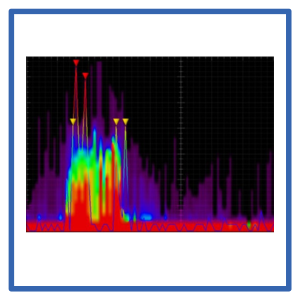Interference or disturbance in the power supply? Find out how to recognise it!

Electromagnetic disturbance in power supplies
Without exception, all power supplies emit electromagnetic disturbances. These are due to the nature of the pulsed electrical power conversion technology, which involves rapid switching of power circuits (switching on and off occurs tens of thousands of times per second). The rapid voltage changes on the transformer (0 to 600V in a microsecond) and the cyclic interruption of the current flowing through the windings cause the metallic components of the power supply electronics to become small antennas and a source of high-frequency energy. This energy tries to escape from the power supply by two routes. The first direction of escape is through propagation through the power supply wires to the mains and the load. This part is called conducted disturbance, because it penetrates the mains along the power cables (mainly the mains cable, but also in part the DC cable). The second part, is the high-frequency energy emitted into the radio ether, like a radio signal through an antenna. This part is called emitted disturbance. The conducted disturbance is attenuated in the power supply by the mains filter and the output choke. The filter is the main barrier not allowing disturbances to escape from the power supply. Emitted disturbance is limited by design, e.g. by suitable transformer construction in which the winding is enclosed inside the core, by shields, by tight construction in which the circuits through which large currents flow have small dimensions, etc.
Interference or disturbance?
In order to speak correctly about electromagnetic phenomena, errors in terms and colloquial definitions must be eliminated at the outset. This is the case with interference, which is used to describe the negative effect of one device on another. It is useful to be precise in technology and avoid colloquial vocabulary. Thus:
Interference is the malfunction, anomaly or inability to use an electronic device as intended. It is the result of something else malfunctioning and adversely affecting it.
A disturbance, on the other hand, is a cause, i.e. something that a device generates that may (but does not necessarily) lead to the malfunction of another.
So a disturbance is an effect and a disturbance is a cause.
A poor power supply emits disturbances. They propagate through power cables or the radio ether, but otherwise nothing bad happens. Nothing suffers because the power supply "sows".
Nevertheless, these electromagnetic disturbances can reach, for example, a radio receiver and cause it to stop receiving broadcasts. This phenomenon is interference (effect). The interference occurs in the equipment exposed to the interference.
A power supply therefore does not emit interference, even though it is colloquially referred to as such. As long as what it radiates into the ether and the network does not cause other equipment in its vicinity to malfunction, there will be no interference.
So let's repeat it again: power supplies emit electromagnetic disturbances. These disturbances reach other devices and may (but not necessarily) cause interference with their operation. If you place a large microwave oven next to a poor power supply, it may be that the power supply will not cause interference to it, even though it is obviously emitting interference all the time and even though a long wave radio will not work next to it at all. Instead, it is the cooker that may (by emitting a strong disturbance) cause interference to the power supply (e.g. its temporary shutdown). From being the perpetrator (the emitter of the disturbance), the power supply has become the victim (the disturbed device).
A power supply emitting disturbance can certainly interfere with a long-wave radio receiver, because the sensitivity in this wave range of the radio is very high. But it is enough to move the radio a few metres away to eliminate the interference. Right? Moving away does not, of course, suddenly make the power supply 'better'. It's just that its disturbance is now not causing interference.
How to deal with interference?
Interference elimination is not an easy subject. It requires practice and an understanding of electromagnetic phenomena. What is more, there is no universal, always effective method and action relies on trial and experimentation. Here are some suggestions for the example when a radio receiver malfunctions in close proximity to the power supply (and is therefore interfered with). In this case, one can:
- Turn the plug on the receiver and power supply socket 180º (because perhaps the emission from the "L" line is greater than the "N" line) and this will weaken the emission a little:
- Move the receiver somewhere further away in the room or at least try to position it differently in relation to the power supply,
- Use a power supply made with Class I insulation and connect it to a socket with a pin,
- Put a ferrite ring on the output and/or input cable,
- Shorten the length of the mains cable or at least coil it tightly instead of leaving it stretched,
- Plug the power supply into another socket in the room,
- Change the power supply to a different type:
- e.g. with a circular DC cable, which has the centre conductor hidden inside and generally emits less disturbance through it,
- to a power supply with a metal enclosure,
- to a power supply of class I (-P3) or with a different output power, as the level of disturbance also depends on the load of the power supply!
All these treatments are designed to make it more difficult for electromagnetic disturbances to propagate.
If such treatments are unsuccessful, you should always consider whether the radio is by chance the problem. There is a good chance that this will be true, because power supplies are generally decently tested, and cheap radios are not checked by anyone to see if they are immune to disturbances. So the next step is to look at whether the radio is of good quality, whether it's connected to an aerial system, or whether it's playing on a piece of wire catching everything in sight from the ether. It could be that the radio has a poor power supply without a mains filter and that this is responsible for the problem, because the interference is "flying through" it.
How to check if the power supply is the cause of the interference? It is best to switch off the power supply for a while and see if the interference continues!
Attention. It is often the case that a power supply in class I and therefore type "P3" is used in a socket without a pin. This is a malfunction and is very often the cause of the interference. Because then the filter in such a power supply only works correctly when the centre conductor is earthed, so the power supply is plugged into a mains socket with a pin. When this is not the case, this middle wire "hangs" in the air which leads to higher emissions. So, to put it another way, the P3 power supply must be plugged into a socket with a pin. Otherwise it will emit too high a disturbance! When the socket has no pin, the correct power supply is a "W2", i.e. with Class II insulation.
